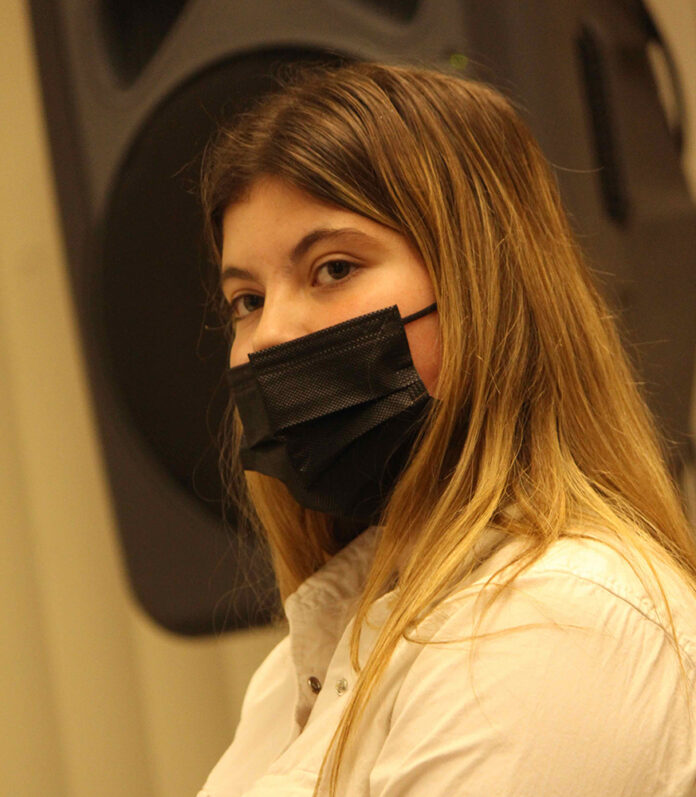
San Lorenzo Valley Unified School District trustees were wowed by the passionate and studied presentation by a student who was trying to persuade them to support an on-campus agricultural program.
Lexi Lemus had originally shown up to speak during a public comment period of the board, but—because of her enthusiasm and preparation—Superintendent Chris Schiermeyer asked her to hold off until the next meeting, so she could have more time to make her case for a 4-H Club.
So, at the Dec. 15 meeting the 16-year-old in her junior year at SLV High School unloaded what turned out to be a wealth of data and support pledges. The big idea was to build a barn at the school site in Felton—something that’s way easier to do than you might think, she pitched.
“This project is ready to go,” she said, outlining the steps she’d taken to gauge student interest and secure community contributions. “It only needs board approval.”
More than 20 students were interested in participating and said they’d contribute their labor to building a barn, the student continued.
Each would be responsible for the cost of their animal, feed and other necessities, Lemus said, explaining her concept.
For example, pigs cost about $230 and could be purchased from a breeder in Turlock called Golden State Genetics, she explained
Lambs cost about $300 and could be sourced from local breeder Julie and Steven Katawicz, she added.
The total cost of raising lambs or goats would be around $425, including feed and hay, Lemus estimated.
Eventually, the animals would be sold at auction and the students might make a little money—or at least cover their costs.
Boulder Creek Pizza & Pub had already made a $150 cash donation, and Scarborough Lumber Ace Hardware contributed $3,168 worth of material to the cause, said Lemus, who pointed to 120 letters of support she’d sourced from locals.
While it would normally cost around $20,000 to build a barn at the school site, she said she’d already been able to bring the total cost down to zero, thanks to pledges from local families and businesses.
“I’d like to compliment you on your great presentation,” said trustee Jacqui Rice, who has participated in local and county 4-H clubs. “Have you ever raised a pig?”
Lemus admitted she had not, replying that having a barn on campus would make such agricultural pursuits more accessible to young people like her.
Rice said Lemus should be realistic about the significant challenge presented by predators.
“The lions come down,” she said. “Or the wild boar come in.”
Chicken wire probably won’t cut it, Rice added.
“I applaud your enthusiasm,” she said. “I have seen the other side of it.”
If a mountain lion kills an animal, it’s not only sad, but it would also represent a loss of hundreds of dollars for a student’s family, Rice commented.
Board President Gail Levine recalled how Soquel High School had an agricultural program when she worked there.
“It was wonderful,” she said. “I also know that there’s a commitment.”
Levine said she’d want to make sure the program was sustainable.
“I applaud you,” she said. “You’re a great salesperson.”
But Levine said there’d be no point to starting a 4-H club just to have it die after a year or two.
“I’m not ready to say no,” she said. “I appreciate the work you’re doing, and I also think it’s a good program for our students to have.”
Trustee Stacy Newsom Kerr agreed that chicken wire wouldn’t be strong enough. She also brought up the issue of what to do about animal feces.
Lemus was prepared to field this answer, too.
Participating students would be required to clean the pen either each day, or at least every other day. And the school could have a system like at Covered Bridge Park, where they have manure trailers, she added.
Newsom Kerr pushed back, noting that an educational facility comes with additional factors to consider.
“You are talking about putting it at a school,” she said. “I just want you to think about it.”
And Newsom Kerr added that, despite Lemus addressing it in her presentation, more thought should be put into what to do about animals during a natural disaster.
Trustee Grace Pollak said the board would need to write an environmental impact report. And she brought up issues around just how easy it would be for low-income families to take part—even with the possibility of a windfall from an auction sale down the line.
“It’s still asking $1,000 for students to participate,” she said. “That doesn’t feel equitable or accessible.”
Pollak suggested the board should pay for the program, the way it pays for drama or sports—if it decides to proceed.
Schiermeyer said, as SLVUSD gets smaller and smaller, adding a new program could mean another falls by the wayside.
Clerk Mark Becker said he sees big things in Lemus’s future, given how prepared she was for the presentation—and how confidently she dealt with objections.
Rice suggested Lemus consider going into marketing or sales.
Levine said the board was taking her idea seriously.
“We’ll be in touch with you,” she said. “We’re not going to just give you lip service.”












